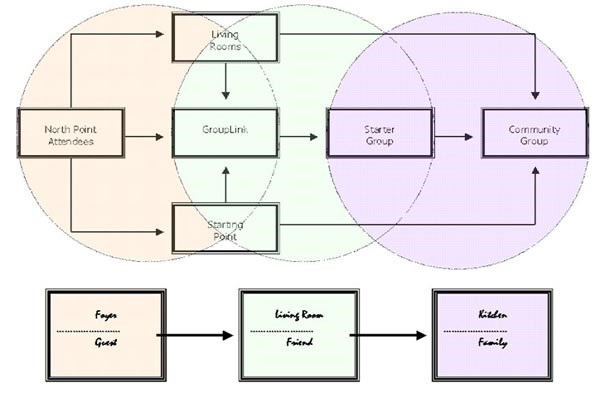Many, if not most, churches employ something I call a "funnel strategy" for building community. The funnel strategy focuses on moving people from a large group (e.g. a weekend service) to small groups and is based on the premise that people will experience more community as they get "closer" to others.
It makes sense and is a critical part of a successful plan for building community. The problem comes when it becomes THE plan. If a funnel strategy constitutes the whole of a church's approach for creating community there can be some unhealthy side effects. Examples include: people feeling they are being pressured to get into a small group and/or people hearing the message that they are not really experiencing community in the church they have decided to call home, or that they are not considered an active member because they have not 'connected' in a small group.
The reality is that life-giving, biblical community is built from a strong sense of belonging. Meeting with a small group of people in close social proximity can be a first step to developing a greater sense of belonging for some, but it can be as inviting as medieval torture for others. That means our strategy for building community has to be more comprehensive. A healthy small group environment represents a laudable end goal and an enabling vehicle for some, but the master strategy needs to also identify alternative ways for others to take that first step to belonging and discover a greater sense of community.
Fortunately, God has graced some of our leading thinkers with fresh ideas on how to make that happen. For example, a book that has stirred up a lot of conversation in the small group community is The Search to Belong, by Joseph Myers, particularly chapter one. In the first chapter, Myers talks about common myths of belonging.
One discipline of study that Myers has brought to bear on small groups in the church is that of "proxemics," which examines how people's perception of space and their experience of it influence the culture in which they live. He discusses four different spaces (public, social, personal, intimate), assigns a space reference distance to each, and then relates each one to a social situation and explains how that situation impacts a person's sense of belonging. Myers' discussion of "the myths of belonging" and the connection with proxemics is fascinating and has sparked very good dialogue about how we talk about and 'do' small groups in the Church.
Another excellent read is Creating Community by Andy Stanley and Bill Willits (North Point Church). North Point wants their people to go into a small group, and their funnel strategy is designed to do just that. Like Myers, they have identified and defined spaces or environments as they call them: foyer (guests), living room (friends), and kitchen (family). Notice how each environment is linked to a person's experience of belonging or community. These three environments form a relational path they hope to move people down with the desire they ultimately will connect into a small group that meets for up to two years. North Point calls these longer-term groups "community groups". They make up North Point's growth track where people can experience authentic community and spiritual growth.
North Point also introduces a step called GroupLink to move people from the living room to the kitchen, (i.e. from friends to family). It is a two-hour event that facilitates connection among people in a similar stage of life and geographic area in attempt to launch an eight-week starter group. A starter group allows participants to 'test drive' the small group experience. The hope is that after this eight-week 'dating period' people will continue on in their groups, and the vast majority do continue.
This is brilliant. Short duration and high meeting frequency fits the busy American culture and tends to result in greater 'stickiness' with groups. However, be aware that the larger the gathering of people at GroupLink, the better it works. It is more challenging to launch affinity groups and groups that will continue meeting beyond the 'dating' period when you have a smaller turnout for GroupLink. For example, it is unlikely you will form affinity groups based on stage of life or geographic area if you have a dozen people show up.
The nugget I gained from what Stanley & Willits shared is the idea of creating steps that will help people in their relational journey of finding a small group that feels like a fit for them. North Point utilizes a funnel strategy, but the problem with funnel strategies is they inadvertently play into some of the myths Myers discusses in his book, especially "more small groups = more belonging".
In the case of North Point, everyone is encouraged to be in a small group because, as Stanley & Willits share, it is there believers can grow in intimacy with God, community with other believers, and influence on unbelievers. Furthermore, they believe that when people are pursuing these three vital relationships, they are growing in their relationship with Jesus Christ. I agree with them that small groups are the best delivery system for leading people into a growing relationship with Christ. However, the problem is that small groups do not always deliver, even when a church like North Point, which has over 10,000 adults attending, is large enough to have a multitude of options for people.
For North Point, small groups are THE delivery system and its ministries are designed to encourage people from the foyer (e.g. weekend services) to the kitchen (e.g. small groups). The implication, which is not the heart of this church, is that somebody is not family if they are not in a small group. Nor would people be viewed as really growing in their relationship with Christ if they are not in a small group. Though I am sure the leadership would not say this, the church's strategy tacitly does.
I am not splitting hairs. What is at stake here is developing more effective strategies for accomplishing the mission Christ has given to His Church. We need to create steps as Stanley & Willits advise, but I think we need to take a more critical look at what constitutes the 'win' for a church. I do not consider somebody "connected" just because they are in a small group. They may be connected in the technical sense, but they may also be miserable! Evaluating success goes beyond the number of people plugged in a small group and includes a qualitative spiritual health assessment of each individual involved.
The challenge Myers has brought to the table has to do with what we are really after with connecting people. What Stanley & Willits are after, what I am after, and what so many churches are after, I have no doubt is the same: Helping more people develop a strong sense of belonging so that we can make more and better disciples (Matthew 28:19-20, Act 1:8, Eph 4:11-16). We just need to be very careful with our strategy. Here is why: Church strategy (like new member assimilation and/or a church's discipleship plan) affects the process we create, and the process we create influences our language. Our language affects our church culture, and our church's culture affects how effective we can be in reaching people for Christ and encouraging their growth together in Him.
Let us pause & summarize for a moment: Funnel strategies are good, but incomplete in themselves. Creating steps is good, but we need to be clear about the path we are asking people to journey on together and where we hope it will ultimately lead them.
I believe Myers has given us an opportunity to stand upon the shoulders of Stanley & Willits by applying his insights about myths of belonging and proxemics to North Point's step process for creating community.
The beauty of North Point's design is that their assimilation strategy is also their community-building strategy, and they introduce steps to help each person along in the process. However, let me suggest a change in the orientation of people's experience of the space within these environments.
We cannot assume that just because people participate in gatherings that are smaller quantitatively than weekend services that their experience of community is greater qualitatively.
Furthermore, we cannot assume that a small group will be the answer for a person's search to belong because they may have already found belonging & purpose in another circle of relationships – and that is okay! (This can create an awesome outreach opportunity over and above "connecting" this person with a bunch of Christians so they can grow spiritually.)
Conversely, people may follow our process, land in a longer-term small group, and not connect with anybody. This can be very discouraging relationally and disheartening missionally for people seeking to belong and bring others to God and His community. Tying people's experience of community (belonging) with participation in physical gatherings is a hazardous presumption for three reasons:
- We cannot presume where people are at (commitment-wise) and what they are experiencing (community-wise) based on their involvement in a ministry or group.
- This can create a church culture where people perceive some as being 'insiders' and others, sadly, as 'outsiders' even though they would say the church is their spiritual family.
- We don not want guests to feel like they have to 'jump through hoops' before they can really belong and be qualified as family. The moment a person enters the household of God, we want them to know they are family whether they 'feel' it yet or not (Eph 1:13, 19-20).

What we can do is create environments that can be more favorable for people to connect, hence, North Point's "living room." Remember, however, we need to be careful about presuming where we think people are and where we think they need to go. Stanley & Willits illustrate their group-connection strategy (p. 128), which shows a left-to-right (horizontal) movement of people from guests to family. That is, you can superimpose their relational path (foyer-guest, living room-friend, kitchen-family) over their strategy to get people into small groups.

I suggest turning the 'axis of environments' so it is vertical and separating this from people's personal experience of community.
Now apply proxemics (public, social, personal, intimate) to each environment in this vertical axis. What this shows is that we cannot assume where people are based on the environment they are occupying at any given time. Instead, we are assuming that we are going to have guests, friends, and family in every gathering. The challenge, then, is to meet people where they are, as opposed to thinking they are not yet family because they have not committed to a small group or that they are not yet a friend because they are not pursuing "community" with others in a mid-size event.
This also allows for us to define a goal or a 'win' for people regardless of what size gathering they are committed to or what they are experiencing as far as space (belonging or community). It is not a small group per se, but the life-giving community that can (but does not always) result from small groups.
North Point's living room environment recasts the concept of an assimilation or fishing pond event and fits it into an overarching small group strategy. This harmonizes with Myers' idea of focusing on creating healthy environments where people can connect instead of the result being small groups. Furthermore, it takes the edge off of some approaches that tell church members that if they REALLY want to feel a part of the family, they need to join a small group.
For example, there are things we can do in the mid-level, "living room" environment that will be revolutionary for the Church for decades to come. What it takes is an attractive large group component (holiday concert, movie night, informative seminar on a hot social topic, etc.) followed by a breakout to discussion groups. Then, conclude the event by offering a relevant, short-term (3-6 week) small group experience on a related theme. For many churches the battle will be won or lost in the environments that are introduced to form a bridge from large to small.
Another way to create steps that can encourage movement from large to small is to host creative events that would be attractive to different affinity-based people groups, e.g. interactive mid-size events that are educational and/or social in nature (live presentation with breakout discussion groups). In these environments, we can promote groups without pushing them. We can encourage community without forcing connection or over-promising the belonging people will experience as a result of taking their time to come.
The goal of these events is to design an environment where connection can occur naturally. They also make for excellent bridge (outreach) events by effectively multiplying entry points into the Church and multiplying possibilities for people (believers and those who have yet to believe) to connect with one another around a shared interest or season of life. Examples of living room events I have done include: holding a seminar on The DaVinci Code, a discussion on "Why Did Jesus Die?" based on the film The Passion, a marriage retreat, and a Parents with Young Kids ministry where participants breakout into table groups for discussion.
What if a church were to host discussion groups based on popular TV programs, books, or films that are stirring up spiritual conversations in our culture? Consider taking an anonymous survey of what programs the families of your church are watching on television at night and what programs they think their friends are watching. Ask yourself: What has become the most popular communication medium of our culture? Jesus once said, "It is not the healthy who need a doctor, but the sick. But go and learn what this means: 'I desire mercy, not sacrifice.' For I have not come to call the righteous, but sinners" (Matthew 9:2b-13).
We cannot force intimacy or belonging, nor can we create community. We CAN, however, shape environments that encourage healthy relationship building in whatever space a person feels they are in…and may want to stay in. From there, God can create life-giving community that meets each person wherever they are, in any size gathering, so your small group ministry will continue to grow strong over the years.
Review content of the following links in this order:
- www.languageofbelonging.com/Puzzled/Aug03_archive.htm
- www.languageofbelonging.com/Puzzled/Sept03_archive.htm
- Then familiarize yourself with the spaces he discusses on this site: www.languageofbelonging.com
For example: www.purposedrivenlife.com/freetools/health.aspx and www.pantego.org/mall/details.cfm?id=1634
Living room events can appeal to believers or a mix of believers and unbelievers. I prefer the latter (a living room event doubling as a bridge event), but it is appropriate to have community-building events that are attractive to believers primarily such as a special study on Ephesians or a seminar on "Scientific Evidence for the Intelligent Design Theory."
See example of SouthLake in the following article: www.purposedriven.com/en-US/AboutUs/PDintheNews/PD_churches_around_the_world_reach_out.htm











